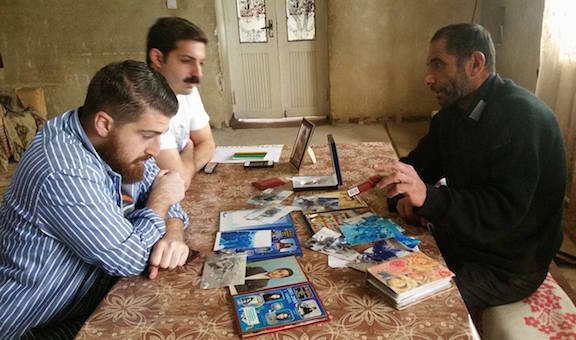
Dickran Khodanian (left) with his colleague Khatchig Joukadjian (far left) visit the the family of Armen Martirosyan, a fallen soldier
BY DICKRAN KHODANIAN
Weeks following the Four Day War in early April, the Armenian Youth Federation’s With Our Soldiers program restarted, but this time with the goal of providing monetary aid to the families of the fallen soldiers. In 2012, the With Our Soldiers campaign was established in order to provide assistance to the veterans of the first Karabakh war. This time, the initiative would provide $1,000 to every family and an additional $250 to every child.
Following the April attacks, AYF members quickly mobilized in order to plan how they could address the issue. This war had ignited a fuel among the AYF members in the Western United States that was vividly seen through their work. Funds were collected immediately and were ready to be dispersed to the families within weeks after the initiative had begun.
At the time, I was living in Armenia volunteering with Birthright Armenia and working on various projects. An on-the-ground task force was then established as a part of the With Our Soldiers Committee comprised of AYF members from the Western United States who currently resided in Armenia. Our responsibility was to arrange the visits to the families of the fallen soldiers and to deliver the financial assistance that was sent to us from the Western United States. The on-the-ground task force contacted the local Armenian Relief Society in Yerevan in order to have a crisis therapist/psychologist accompany us with all of our visits. When we started organizing all of the visits, an ARS member was definitely a necessary component of our visits due to the circumstances.
After visiting Artsakh multiple times and developing lifelong friendships with the locals, Artsakh had already left an everlasting impression on me. It was clear why so many brave and courageous people fought for and helped liberate this small piece of land. However, as a diasporan, you can’t help to feel helpless sometimes, especially when you constantly hear Azeri ceasefire violations at the border resulting in the death of yet another Armenian soldier. How do I contribute? What am I even able to do? At the time, since I was living in Armenia, there was no hesitation when I agreed to work on this campaign, no matter how difficult just the thought of visiting these families sounded. I knew it was not going to be an easy task, but my experience following these visits truly surpassed any thoughts or notions I had. Until today, there are no words to describe what I experienced. Just thinking about gathering my thoughts, and putting everything down onto paper made me both emotional and proved to be a challenge.
Through my work with this program, I was able to visit over 40 families and travelled extensively throughout Armenia. Each visit was distinct and even more difficult than the next. Every soldier had their own story and most of the families were more than willing to talk about their son and how proud they were of their patriotic son who became a hero and gave his life to his nation. There were families who lost their only son. There were families that lost their only child. There were families that lost their son and husband who left a wife with three kids. And there were families who lost their only breadwinner of the family. As I would mentally prepare for these visits, the question of “What can I possibly say to these families that’s going to help?”